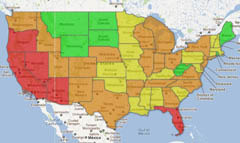Cronkite News has moved to a new home at cronkitenews.azpbs.org. Use this site to search archives from 2011 to May 2015. You can search the new site for current stories.
Report: Arizona’s very poor face very hard time finding affordable housing
WASHINGTON – Tara Jackson has been living paycheck-to-paycheck for three years so she could afford to rent in a safe Tucson neighborhood where her two teenage sons would not be exposed to drugs or gangs.
But the single mother said she does not know how much longer she will be able to keep it up. Laid off in October from her job as a health clinic administrator, after using up her unpaid medical leave, Jackson now relies on unemployment benefits and a stipend that will help pay the rent through June.
“I’m trying to move and find another decent area that’s in a price range that I can afford, but they want $1,100, $1,200 a month,” said Jackson, who said rent previously consumed more than half her income. “It kind of puts you in a hole. Either you’re going to settle and live in a dysfunctional area of town or you’re going to struggle to pay this high rent.”
Jackson is not alone. There is a growing shortage of affordable housing in the country and the situation is even more severe in Arizona, according to the National Low Income Housing Coalition.
It said in a recent report that Arizona is the second-worst state in the country when it comes to affordable and available rental housing for “extremely low income” households, or those making 30 percent of the region’s median family income. In Tucson, that would include households earning less than $17,880 per year.
For every 100 such households there were only 20 rental units that were affordable and available in Arizona in 2010, said the report, “The Shrinking Supply of Affordable Housing.”
Only Nevada was worse, with 17 available units per 100 extremely low-income renters.
“That’s definitely a number to focus on,” said Megan Bolton, a senior research analyst for the report. “It’s a pretty severe shortage in Arizona.”
Arizona also finished second-to-last – again behind Nevada – for the percentage of extremely low-income households with a severe housing cost burden. The report said 83 percent of such households spend more than half their monthly income on housing and utilities.
Bolton said the situation in Nevada and Arizona can be partly attributed to their high foreclosure rates, which has “driven a lot of people back into renting from home owning.”
“There’s just a lot more people demanding rental units, which is both driving the price up and making those units unavailable to the lowest-income households,” she said.
But state officials say Arizona’s problems are no more severe than the rest of the country’s.
“It kind of follows the logic . . . as you get into lower incomes, the degree of severity probably increases, which is what we’re seeing,” said Michael Trailor, director of the Arizona Department of Housing. “It’s much harder to produce housing units for that group. You almost can’t charge any rent because their income is so low.”
Only 13 states, including Arizona, fell below the national average of 30 affordable and available rental units for every 100 extremely low-income households.
States that beat the national average have various affordable housing programs to help people pay rent, Bolton said. She pointed to the success of state housing trust funds and said a national housing trust fund – created in 2008, but never funded – is needed to help extremely low-income families.
“We don’t see the market right now making rent more affordable for those people,” Bolton said.
Arizona has a state housing trust fund that provides assistance to extremely low-income families, but it has been cut from $30 million to $2.5 million in recent years.
“That just happened in this recession. This hasn’t been a long-term issue,” Trailor said. “Certainly there’s a lot more we could do with $30 million than the $2.5 million. It’s really only affected us in the last four years.”
Valerie Iverson, executive director of Arizona Housing Alliance, said foreclosures have had a “ripple effect to the lowest-income families in the state,” but there are other factors contributing to the rental housing shortage.
The sprawling development of states like Arizona and Nevada result in a “geographic mismatch” between where people can afford to live and where they want to live, Iverson said.
“The most affordable housing is on the fringes of our metropolitan areas,” she said. “It’s kind of the drive-’til-you-qualify mentality. People would keep driving out further and further until they get to an area where they qualify.”
But for Jackson, that area also has to be a safe one.
In addition to her 16- and 18-year-old sons, she frequently cares for her 2-year-old grandson, the child of a daughter who does not live with her. Jackson said she is not willing to risk their futures for an easier time paying the bills.
“I have come across some three-bedroom houses or apartments that are pretty reasonable rentalwise, but the area – it’s a really big risk,” said the 41-year-old Tucson native.
With her job of 18 years gone and her rental assistance scheduled to run out in a few months, Jackson knows she should have the “take what you can as long as we have a roof over our heads” mentality. But she won’t.
“I can’t even look at the situation like that because there are consequences,” she said. “Their well-being is a little more important than that.”







